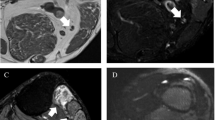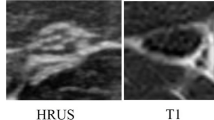Abstract
Objective
To evaluate the impact of magnetic resonance neurography (MRN) on diagnostic thinking and therapeutic choices in patients with suspected peripheral neuropathy.
Methods
IRB approval was obtained for this HIPAA-compliant study. Questionnaires were administered to six surgeons regarding the diagnosis and treatment in 85 patients suspected of having peripheral neuropathy, before (pretest) and after (posttest) MRN. Multiple outcome measures related to diagnostic confidence and surgical decision-making were assessed.
Results
The final cohort included 81 patients (30 men and 51 women, age 47 ± 17 years). The following changes were observed from pretest to posttest questionnaires: 23 % in nerve involvement (P < 0.05), 48 % in degree of confidence of nerve involvement (P < 0.01), 27 % in grade of injury (P < 0.05), 33 % in differential diagnosis (P < 0.05), 63 % in degree of confidence in need for surgery (P < 0.001), 41 % in timing of surgery (P < 0.01), 30 % in approach to surgery (P < 0.05), 58 % in degree of confidence in approach to surgery (P < 0.001), 30 % in estimated length of surgery (P < 0.05) and 27 % in length of incision (P < 0.05). The dichotomous decision regarding surgical or nonsurgical treatment changed from pro to con in 17 %.
Conclusion
MRN results significantly influenced the diagnostic thinking and therapeutic recommendations of peripheral nerve surgeons.
Key Points
• In patients with peripheral neuropathy, MRN significantly impacts diagnostic thinking.
• In patients with peripheral neuropathy, MRN significantly impacts therapeutic choices.
• 3-T MRN should be considered in presurgical planning of patients with peripheral neuropathy.





Similar content being viewed by others
References
Filler AG, Maravilla KR, Tsuruda JS (2004) MR neurography and muscle MR imaging for image diagnosis of disorders affecting the peripheral nerves and musculature. Neurol Clin 22(643–682):vi–vii
Andreisek G, Burg D, Studer A, Weishaupt D (2008) Upper extremity peripheral neuropathies: role and impact of MR imaging on patient management. Eur Radiol 18:1953–1961
Thawait SK, Chaudhry V, Thawait GK et al (2011) High-resolution MR neurography of diffuse peripheral nerve lesions. AJNR Am J Neuroradiol 32:1365–1372
Siemionow M, Brzezicki G (2009) Chapter 8: current techniques and concepts in peripheral nerve repair. Int Rev Neurobiol 87:141–172
Bäumer P, Dombert T, Staub F et al (2011) Ulnar neuropathy at the elbow: MR neurography–nerve T2 signal increase and caliber. Radiology 260:199–206
Chhabra A, Subhawong TK, Williams EH et al (2011) High-resolution MR neurography: evaluation before repeat tarsal tunnel surgery. AJR Am J Roentgenol 197:175–183
Chhabra A, Chalian M, Soldatos T et al (2012) 3-T high-resolution MR neurography of sciatic neuropathy. AJR Am J Roentgenol 4:W357–W364
Viallon M, Vargas MI, Jlassi H, Lövblad KO, Delavelle J (2008) High-resolution and functional magnetic resonance imaging of the brachial plexus using an isotropic 3D T2 STIR (Short Term Inversion Recovery) SPACE sequence and diffusion tensor imaging. Eur Radiol 18:1018–1023
Vargas MI, Viallon M, Nguyen D, Beaulieu JY, Delavelle J, Becker M (2010) New approaches in imaging of the brachial plexus. Eur J Radiol 74:403–410
Lee PP, Chalian M, Bizzell C et al (2012) Magnetic resonance neurography of common peroneal (fibular) neuropathy. J Comput Assist Tomogr 36:455–461
Soldatos T, Andreisek G, Thawait GK et al (2013) High-resolution 3-T MR neurography of the lumbosacral plexus. Radiographics 33:967–987
Jarvik JG (2001) The research framework. AJR Am J Roentgenol 176:873–878
Chhabra A (2014) Peripheral MR neurography: approach to interpretation. Neuroimaging Clin N Am 24:79–89
Seddon HJ (1948) A review of work on peripheral nerve injuries in Great Britain during World War II. J Nerv Ment Dis 108:160–168
Graham MM (2009) Cost-effectiveness of medical imaging. Lancet Oncol 10:744–745
Heidenreich PA (2009) Assessing the value of a diagnostic test. Arch Intern Med 169:1262–1264
Keen NN, Chin CT, Engstrom JW, Saloner D, Steinbach LS (2012) Diagnosing ulnar neuropathy at the elbow using magnetic resonance neurography. Skelet Radiol 4:401–407
Ladak A, Spinner RJ, Amrami KK, Howe BM (2013) MRI findings in patients with tibial nerve compression near the knee. Skelet Radiol 42:553–559
Schwarz D, Weiler M, Pham M, Heiland S, Bendszus M, Bäumer P (2015) Diagnostic signs of motor neuropathy in MR neurography: nerve lesions and muscle denervation. Eur Radiol 25:1497–1503
Baumer P, Kele H, Kretschmer T, Koenig R, Pedro M, Bendszus M, Pham M (2014) Thoracic outlet syndrome in 3T MR neurography-fibrous bands causing discernible lesions of the lower brachial plexus. Eur Radiol 24:756–761
Breitenseher JB, Kranz G, Hold A, Berzaczy D, Nemec SF, Sycha T, Weber M, Prayer D, Kasprian G (2015) MR neurography of ulnar nerve entrapment at the cubital tunnel: a diffusion tensor imaging study. Eur Radiol 25:1911–1918
Jengojan S, Kovar F, Breitenseher J, Weber M, Prayer D, Kasprian G (2015) Acute radial nerve entrapment at the spiral groove: detection by DTI-based neurography. Eur Radiol 25:1678–1683
Chhabra A, Thawait GK, Soldatos T et al (2013) Resolution 3T MR neurography of the brachial plexus and its branches, with emphasis on 3D imaging. AJNR Am J Neuroradiol 34:486–497
Kasper JM, Wadhwa V, Scott KM, Rozen S, Xi Y, Chhabra A (2015) SHINKEI–a novel 3D isotropic MR neurography technique: technical advantages over 3DIRTSE-based imaging. Eur Radiol 25:1672–1677
Takahara T, Hendrikse J, Kwee TC, Yamashita T, Van Cauteren M, Polders D, Boer V, Imai Y, Mali WP, Luijten PR (2010) Diffusion-weighted MR neurography of the sacral plexus with unidirectional motion probing gradients. Eur Radiol 20:1221–1226
Kim SJ, Hong SH, Jun WS et al (2011) MR imaging mapping of skeletal muscle denervation in entrapment and compressive neuropathies. Radiographics 31:319–325
Grant GA, Goodkin R, Maravilla KR, Kliot M (2004) MR neurography: diagnostic utility in the surgical treatment of peripheral nerve disorders. Neuroimaging Clin N Am 14:115–133
Merlini L, Vargas MI, Anooshiravani M, Viallon M, Fluss J, Hanquinet S (2011) Look or the nerves! MR neurography adds essential diagnostic value to routine MRI in pediatric practice: a pictorial overview. J Neuroradiol 38:141–147
Du R, Auguste KI, Chin CT, Engstrom JW, Weinstein PR (2010) Magnetic resonance neurography for the evaluation of peripheral nerve, brachial plexus, and nerve root disorders. J Neurosurg 112:362–371
Donovan A, Rosenberg ZS, Cavalcanti CF (2010) MR imaging of entrapment neuropathies of the lower extremity. Part 2. The knee, leg, ankle, and foot. Radiographics 30:1001–1019
Subhawong TK, Wang KC, Thawait SK (2012) High resolution imaging of tunnels by magnetic resonance neurography. Skelet Radiol 41:15–31
Zhang H, Xiao B, Zou T (2006) Clinical application of magnetic resonance neurography in peripheral nerve disorders. Neurosci Bull 22:361–367
Kim JH, Won SJ, Rhee WI, Park HJ, Hong HM (2015) Diagnostic cutoff value for ultrasonography in the ulnar neuropathy at the elbow. Ann Rehabil Med 39:170–175
Abrishamchi F, Zaki B, Basiri K, Ghasemi M, Mohaghegh M (2014) A comparison of the ultrasonographic median nerve cross-sectional area at the wrist and the wrist-to-forearm ratio in carpal tunnel syndrome. J Res Med Sci 19:1113–1117
El Miedany Y, El Gaafary M, Youssef S, Ahmed I, Nasr A (2015) Ultrasound assessment of the median nerve: a biomarker that can help in setting a treat to target approach tailored for carpal tunnel syndrome patients. Springerplus 4:13
Acknowledgements
The scientific guarantor of this publication is Dr. Avneesh Chhabra. The authors of this manuscript declare relationships with Siemens, Carestream and Toshiba. The authors of this manuscript declare no relationships with any companies whose products or services may be related to the subject matter of the article. This study has received funding by GEAUR and Siemens. Dr. John Eng kindly provided statistical advice for this manuscript. Two of the authors (Majid Chalian and Sahar J. Farahani) have significant statistical expertise. No complex statistical methods were necessary for this paper. Institutional review board approval was obtained. Institutional review board approval was obtained for one-third of the patients. The other two-thirds were enrolled following waiver of consent under another related IRB, since the scans were performed before they could be consented as part of their clinical care. This study is an observational cross-sectional study performed at Johns Hopkins Hospital, Baltimore, MD. The author would like to thank editor John Garinn, UTSW Department of Radiology, for his contribution to the manuscript.
Author information
Authors and Affiliations
Corresponding author
Appendix
Appendix

Rights and permissions
About this article
Cite this article
Chhabra, A., Belzberg, A.J., Rosson, G.D. et al. Impact of high resolution 3 tesla MR neurography (MRN) on diagnostic thinking and therapeutic patient management. Eur Radiol 26, 1235–1244 (2016). https://doi.org/10.1007/s00330-015-3958-y
Received:
Revised:
Accepted:
Published:
Issue Date:
DOI: https://doi.org/10.1007/s00330-015-3958-y




